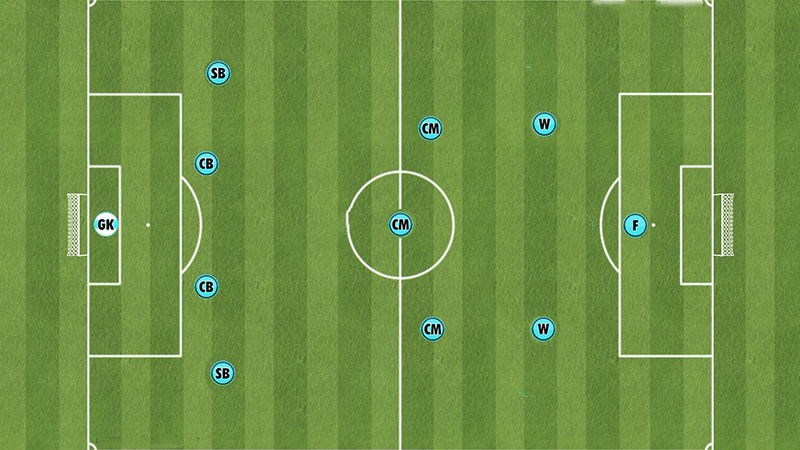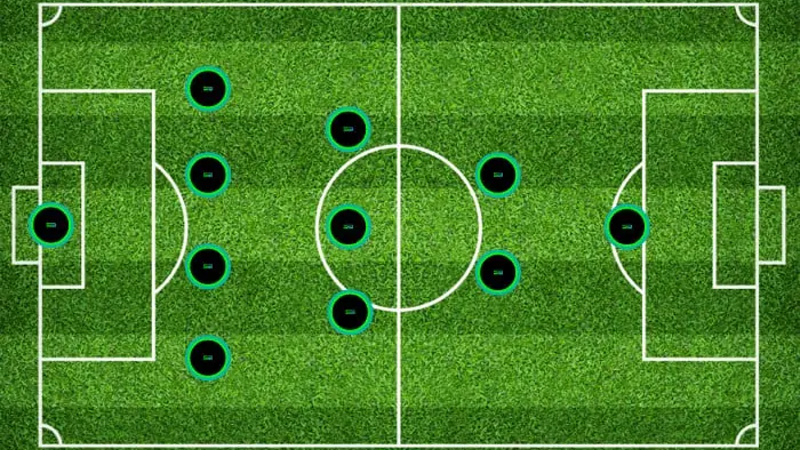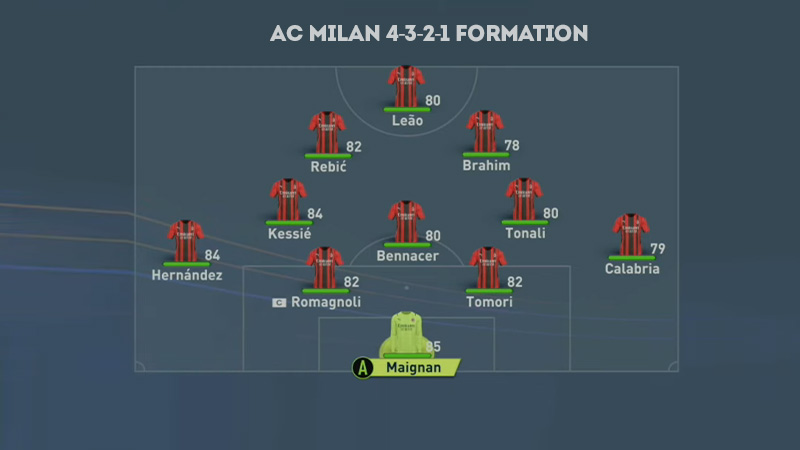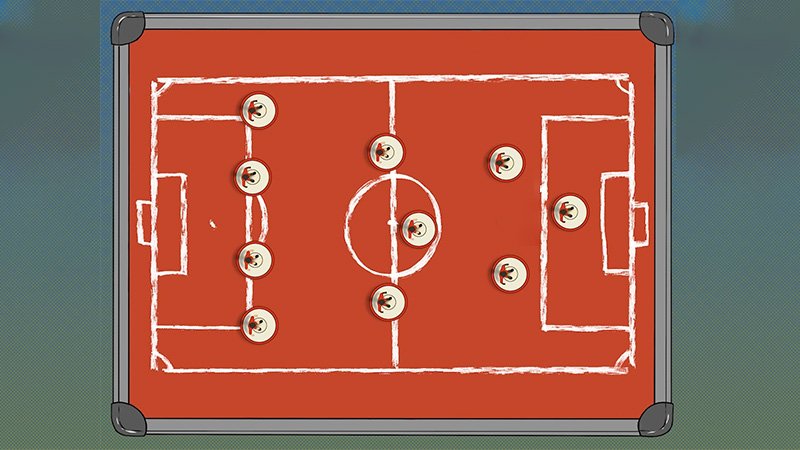In the dynamic world of soccer tactics, the 4-3-2-1 formation has emerged as a popular choice for teams seeking a balanced approach to the game.
Also known as the “Christmas Tree” formation, this tactical setup offers a compact and flexible structure that combines defensive solidity with attacking prowess.
With four defenders forming a solid backline, three central midfielders providing a shield, and two attacking midfielders supporting a lone striker, the 4-3-2-1 formation creates a cohesive unit capable of controlling the game and exploiting counter-attacking opportunities.
However, the formation does come with its weaknesses, such as a lack of width and vulnerability on the flanks.
By understanding the intricacies of the 4-3-2-1 formation and utilizing the right personnel, teams can unlock their potential and achieve success on the soccer field.
In this article, we will delve into the intricacies of the 4-3-2-1 soccer formation, exploring its strengths, weaknesses, and key players’ roles.
What Is the 4-3-2-1 Soccer Formation?
The 4-3-2-1 formation, also known as the “Christmas Tree” formation, is a tactical setup in soccer that consists of four defenders, three central midfielders, two attacking midfielders, and a lone striker.
The name “Christmas Tree” comes from the shape the formation creates on the field, resembling a Christmas tree when viewed from above.
In this formation, the four defenders typically consist of two central defenders and two full-backs. The central midfielders form a trio in the middle of the pitch, with one midfielder often assuming a more defensive role and the other two providing a balance of defensive cover and creative distribution.
The two attacking midfielders, often referred to as the “number 10s,” play between the lines, supporting the lone striker and creating goal-scoring opportunities. The lone striker’s role is to lead the attacking line, hold up the ball, and create space for the attacking midfielders.
How to Play a 4-3-2-1 Soccer Formation?

The 4-3-2-1 formation, also known as the Christmas Tree formation, is a popular soccer formation that provides a solid defensive structure while maintaining attacking options. Here’s a breakdown of how to play this formation:
Goalkeeper (GK)
- The goalkeeper remains in the goal and acts as the last line of defense.
- Their primary role is to stop shots on goal and distribute the ball to initiate attacks.
Defenders (4)
- The backline consists of four defenders, typically two center-backs (CB) and two full-backs (FB).
- The center-backs provide stability and cover the central areas, while the full-backs provide width and support in both defense and attack.
- The defenders should communicate well, maintain a solid defensive line, and be ready to make tackles and interceptions.
Midfielders (3)
- The midfield trio consists of a defensive midfielder (CDM) and two central midfielders (CM).
- The defensive midfielder acts as a shield for the defense, breaking up opposition attacks and distributing the ball to the more advanced players.
- The central midfielders have a dual role of supporting the defense and linking up with the attacking players.
- The midfielders should maintain good positional discipline, provide passing options, and contribute to both defensive and offensive phases of play.
Attacking Midfielders (2)
- The two attacking midfielders, often referred to as the “number 10s” (AM), play just behind the lone striker.
- Their primary responsibility is to create goal-scoring opportunities by providing through balls, making runs into the box, and taking shots from a distance.
- The attacking midfielders should have good vision, creativity, and the ability to link up with both the midfielders and the striker.
Striker (1)
- The lone striker, also known as the center forward (CF), leads the attacking line.
- Their main objective is to score goals by getting into goal-scoring positions, holding up the ball, and creating space for the attacking midfielders.
- The striker should have good finishing ability, be comfortable with both feet and possess a good aerial presence.
Key Points
- Communication and coordination among players are crucial for the success of this formation.
- The full-backs should provide width in attack while being mindful of defensive duties.
- The attacking midfielders should have a good understanding with the striker and midfielders to create effective attacking combinations.
- The defensive midfielder should provide cover for the center-backs and act as a link between defense and attack.
- The formation can be adjusted during the game based on the team’s strategy and the opposition’s tactics.
Remember, formations are not set in stone and can be adapted to suit the team’s strengths, weaknesses, and style of play.
Why Use the 4-3-2-1 Soccer Formation?

Source: soccerblade
The 4-3-2-1 soccer formation offers several advantages that make it a popular choice for teams. Here are some reasons why teams might choose to use this formation:
Defensive Solidity
The 4-3-2-1 formation provides a solid defensive structure with four defenders and a defensive midfielder. This setup allows for good coverage of the defensive areas, making it difficult for the opposition to penetrate through the middle.
Compactness
The formation’s triangular midfield shape, with three central midfielders, creates a compact and organized midfield. This makes it easier to control the central areas of the pitch, limiting the opposition’s passing options and forcing them wide.
Counter-Attacking Potential
With two attacking midfielders playing just behind the lone striker, the 4-3-2-1 formation offers great potential for quick counter-attacks. The attacking midfielders can exploit spaces left by the opposition’s full-backs and create goal-scoring opportunities with their positioning and creativity.
Flexibility
The formation allows for flexibility in both defense and attack. The full-backs can push forward to provide width in attack, while the attacking midfielders can drop deeper to support the midfield or move wider to stretch the opposition’s defense.
Overloading the Midfield
With three central midfielders, the team can outnumber the opposition in the midfield area. This can help in winning the battle for possession, controlling the tempo of the game, and creating passing options for the players in possession.
Defensive Cover
The defensive midfielder acts as a shield for the defense, providing additional cover and protection. This helps in breaking up opposition attacks and reducing the space for the opposition’s attacking players to operate.
Balance Between Defense and Attack
The 4-3-2-1 formation strikes a good balance between defensive solidity and attacking options. It allows the team to have a strong defensive foundation while still having enough players in advanced positions to create goal-scoring opportunities.
It’s important to note that the choice of formation depends on various factors, including the team’s style of play, the strengths and weaknesses of the players, and the opposition’s tactics.
Coaches may choose to adapt or modify the formation based on these factors to maximize the team’s performance.
Which Clubs Use the 4-3-2-1 Formation?

While the choice of formation can vary from game to game and season to season, several clubs have used the 4-3-2-1 formation at different points. Here are a few examples of clubs that have employed this formation:
AC Milan
AC Milan, one of Italy’s most successful clubs, has used the 4-3-2-1 formation under various managers. It has been a preferred formation for them in recent years, providing a solid defensive structure while allowing their attacking midfielders to create scoring opportunities.
Tottenham Hotspur
Tottenham Hotspur, an English Premier League club, has utilized the 4-3-2-1 formation under former manager Mauricio Pochettino. This formation allowed them to have a strong midfield presence while providing attacking options through their creative midfielders.
Borussia Dortmund
Borussia Dortmund, a German club known for its attacking style of play, has occasionally used the 4-3-2-1 formation. This formation allows them to have a compact midfield while providing support to their lone striker and creating goal-scoring opportunities.
Atletico Madrid
Atletico Madrid, a Spanish club known for its defensive solidity, has employed the 4-3-2-1 formation under manager Diego Simeone. This formation allows them to maintain a strong defensive structure while having attacking options through their advanced midfielders.
RB Leipzig
RB Leipzig, a German club that has risen to prominence in recent years, has used the 4-3-2-1 formation under manager Julian Nagelsmann. This formation allows them to have a balanced approach, with a solid midfield base and creative options in the attacking midfield positions.
It’s important to note that formations can change based on the team’s strategy, the players available, and the opposition’s tactics. Clubs often adapt their formations to suit the strengths and weaknesses of their squad and the specific requirements of each game.
FAQs
How can teams overcome the lack of width in the 4-3-2-1 formation?
To overcome the lack of width in the 4-3-2-1 formation, teams can rely on overlapping runs from the full-backs. The full-backs should be encouraged to push forward and provide width in the attacking phase, creating additional options for crosses and stretching the opposition’s defense.
How can teams defend against attacks down the flanks in the 4-3-2-1 formation?
Defending against attacks down the flanks in the 4-3-2-1 formation requires a collective effort. The central midfielders should be proactive in tracking back and providing cover for the full-backs when they push forward. The attacking midfielders should also be willing to drop deeper and help defend the wide areas. How can the lone striker be effective in the 4-3-2-1 formation?
The lone striker in the 4-3-2-1 formation plays a pivotal role in leading the attacking line. To be effective, the striker should possess good hold-up play skills, allowing them to receive and retain possession while waiting for support from the attacking midfielders.
How can teams exploit counter-attacking opportunities in the 4-3-2-1 formation?
The 4-3-2-1 formation is well-suited for counter-attacking football. To exploit counter-attacking opportunities, teams should focus on quick transitions from defense to attack.
When winning the ball back, the central midfielders should look to release the attacking midfielders and lone striker with accurate and incisive passes.
Can the 4-3-2-1 formation be adjusted to suit different styles of play?
Yes, the 4-3-2-1 formation can be adjusted to suit different styles of play. Coaches can make slight modifications to the roles and positioning of players within the formation to adapt to specific game plans.
For example, the central midfielders can be instructed to play more defensively or offensively based on the team’s strategy.
Bottom Line
The 4-3-2-1 soccer formation, also known as the “Christmas Tree,” offers a tactical solution that combines defensive solidity, compactness, and attacking options. Its balanced approach allows teams to control the game, exploit counter-attacking opportunities, and create goal-scoring chances.
However, coaches must be aware of the formation’s weaknesses, such as a lack of width and vulnerability on the flanks. By addressing these weaknesses and leveraging the strengths of the formation, teams can maximize their potential on the soccer field.
Whether it’s a top-level professional team or a youth academy, the 4-3-2-1 formation offers an exciting and dynamic approach to the beautiful game.
With careful planning, training, and player development, teams can harness the power of the “Christmas Tree” formation to achieve their goals and leave a lasting impact on the field.







